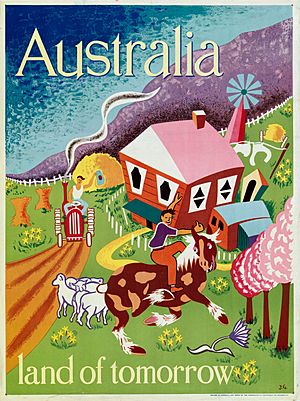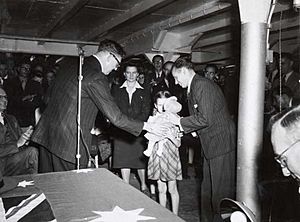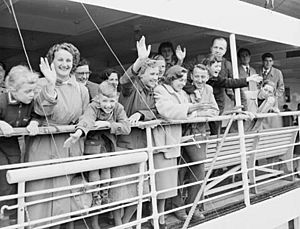Post-war immigration to Australia facts for kids
Post-war immigration to Australia deals with migration to Australia in the decades immediately following World War II, and in particular refers to the predominantly European wave of immigration which occurred between 1945 and the end of the White Australia policy in 1973. In the immediate aftermath of World War II, Ben Chifley, Prime Minister of Australia (1945–1949), established the federal Department of Immigration to administer a large-scale immigration program. Chifley commissioned a report on the subject which found that Australia was in urgent need of a larger population for the purposes of defence and development and it recommended a 1% annual increase in population through increased immigration.
The first Minister for Immigration, Arthur Calwell, promoted mass immigration with the slogan "populate or perish". It was Billy Hughes, as Minister for Health and Repatriation, who had coined the "populate or perish" slogan in the 1930s. Calwell coined the term "New Australians" in an effort to supplant such terms as Balt, pommy (Englishman) and wog.
The 1% target remained a part of government policy until the Whitlam government (1972–1975), when immigration numbers were substantially cut back, only to be restored by the Fraser government (1975–1982).
Some 4.2 million immigrants arrived between 1945 and 1985, about 40 percent of whom came from Britain and Ireland. 182,159 people were sponsored by the International Refugee Organisation (IRO) from the end of World War II up to the end of 1954 to resettle in Australia from Europe—more than the number of convicts transported to Australia in the first 80 years after European settlement.
Contents
"Populate or perish" policy
The Chifley years
Following the attacks on Darwin and the associated fear of Imperial Japanese invasion in World War II, the Chifley government commissioned a report on the subject which found that Australia was in urgent need of a larger population for the purposes of defence and development and it recommended a 1% annual increase in population through increased immigration. In 1945, the government established the federal Department of Immigration to administer the new immigration program. The first Minister for Immigration was Arthur Calwell. An Assisted Passage Migration Scheme was also established in 1945 to encourage Britons to migrate to Australia. The government's objective was summarised in the slogan "populate or perish". Calwell stated in 1947, to critics of mass immigration from non-British Europe: "We have 25 years at most to populate this country before the yellow races are down on us."
The post-war immigration program of the Chifley government gave them preference to migrants from Great Britain, and initially an ambitious target was set of nine British out of ten immigrants. However, it was soon apparent that even with assisted passage the government target would be impossible to achieve given that Britain's shipping capacity was quite diminished from pre-war levels. As a consequence, the government looked further afield to maintain overall immigration numbers, and this meant relying on the IRO refugees from Eastern Europe, with the US providing the necessary shipping. Many Eastern Europeans were refugees from the Red Army and thus mostly anti-Communist and so politically acceptable.
Menzies years

The 1% target survived a change of government in 1949, when the Menzies government succeeded Chifley's. The new Minister of Immigration was Harold Holt (1949–56).
The British component remained the largest component of the migrant intake until 1953. Between 1953 and late 1956, migrants from Southern Europe outnumbered the British, and this caused some alarm in the Australian government, causing it to place restrictions on Southern Europeans sponsoring newcomers and to commence the "Bring out a Briton" campaign. With the increase in financial assistance to British settlers provided during the 1960s, the British component was able to return to the top position in the overall number of new settlers.
Hundreds of thousands of displaced Europeans migrated to Australia and over 1,000,000 Britons immigrated with financial assistance. The migration assistance scheme initially targeted citizens of Commonwealth countries; but it was gradually extended to other countries such as the Netherlands and Italy. The qualifications were straightforward: migrants needed to be in sound health and under the age of 45 years. There were initially no skill requirements, although under the White Australia policy, people from mixed-race backgrounds found it very difficult to take advantage of the scheme.
Migration brought large numbers of southern and central Europeans to Australia for the first time. A 1958 government leaflet assured voters that unskilled non-British migrants were needed for "labour on rugged projects ...work which is not generally acceptable to Australians or British workers." The Australian economy stood in sharp contrast to war-ravaged Europe, and newly arrived migrants found employment in a booming manufacturing industry and government assisted programmes such as the Snowy Mountains Scheme. This hydroelectricity and irrigation complex in south-east Australia consisted of sixteen major dams and seven power stations constructed between 1949 and 1974. It remains the largest engineering project undertaken in Australia. Necessitating the employment of 100,000 people from over 30 countries, to many it denotes the birth of multicultural Australia.
In 1955 the one-millionth post-war immigrant arrived in Australia. Australia's population reached 10 million in 1959, up from 7 million in 1945.
End to the White Australia policy
In 1973, Whitlam government (1972–1975) adopted a completely non-discriminatory immigration policy, effectively putting an end to the White Australia policy. However, the change occurred in the context of a substantial reduction in the overall migrant intake. This ended the post-war wave of predominantly European immigration which had started three decades before with the end of the Second World War and would make the beginnings of the contemporary wave of predominantly Asian Immigration to Australia which continues to the present day.
International agreements
Financial assistance was an important element of the post war immigration program and as such there were a number of agreements in place between the Australian government and various governments and international organisations.
- United Kingdom – free or assisted passages. Immigrants under this scheme became known as Ten Pound Poms.
- Assisted passages for ex-servicemen of the British Empire and the United States. This scheme was later extended to cover ex-servicemen and members of resistance movements from certain other Allied countries.
- An agreement with the International Refugee Organization (IRO) to settle at least 12,000 displaced people a year from camps in Europe. Australia accepted a disproportionate share of refugees sponsored by IRO in the late 1940s and early 1950s.
- Formal migration agreements, often involving the grant of assisted passage, with the United Kingdom, Malta, the Netherlands, Italy, West Germany, Turkey and Yugoslavia.
- There were also informal migration agreements with a number of other countries including Austria, Greece, Spain, and Belgium.
Timeline
| Period | Events |
|---|---|
| 1947 | Australia's first migrant reception centre opened at Bonegilla, Victoria – the first assisted migrants were received there in 1951. |
| 1948 | Australia signed Peace treaties with Italy, Romania, Bulgaria and Hungary and accepted immigrants from these countries. |
| 1949 | In 1949 assisted arrivals reached more than 118,800, four times the 1948 figure.
In August Australia welcomed its 50,000th "New Australian" — or rather, the 50,000th displaced person sponsored by the IRO and to be resettled in Australia. The child was from Riga, Latvia. Work began on the Snowy Mountains Scheme – a substantial employer of migrants: 100,000 people were employed from at least 30 different nationalities. Seventy percent of all the workers were migrants. |
| 1950 | Net Overseas Migration was 153,685, the third highest figure of the twentieth century. |
| 1951 | The first assisted migrants received at the Bonegilla Migrant Reception and Training Centre. By 1951, the government had established three migrant reception centres for non-English speaking displaced persons from Europe, and twenty holding centres, principally to house non-working dependants, when the pressure of arrival numbers on the reception centres was too great to keep families together. |
| 1952 | The IRO was abolished and from then most refugees who resettled in Australia during the 1950s were brought here under the auspices of the Intergovernmental Committee for European Migration (ICEM). |
| 1954 | The 50,000th Dutch migrant arrived. |
| 1955 | Australia's millionth post-war immigrant arrived. She was a 21-year-old from the United Kingdom and newly married. |
| 1971 | Migrant camp at Bonegilla, Victoria closed – some 300,000 migrants had spent time there. |
Settler arrivals by top 10 countries of birth
| Birthplace | July 1949 – June 1959 | July 1959 – June 1970 | July 1970 – June 1980 |
|---|---|---|---|
| United Kingdom & Ireland | 419,946 (33.5%) | 654,640 (45.3%) | 342,373 (35.8%) |
| Italy | 201,428 (16.1%) | 150,669 (10.4%) | 28,800 (3.0%) |
| New Zealand | 29,649 (2.4%) | 30,341 (2.1%) | 58,163 (6.1%) |
| Germany | 162,756 (13.0%) | 50,452 (3.5%) | not in top 10 |
| Greece | 55,326 (4.4%) | 124,324 (8.6%) | 30,907 (3.2%) |
| Yugoslavia | not in top 10 | 94,555 (6.5%) | 61,283 (6.4%) |
| Netherlands | 100,970 (8.1%) | 36,533 (2.5%) | not in top 10 |
| Malta | 38,113 (3.0%) | 28,916 (2.0%) | not in top 10 |
| US | 16,982 (1.4%) | 20,467 (1.4%) | 27,769 (2.9%) |
| Spain | not in top 10 | 17,611 (1.2%) | not in top 10 |
| Total settler arrivals | 1,253,083 | 1,445,356 | 956,769 |
Breakdown of arrivals by decade
- Immigrants who arrived in Australia (by decade of arrival) as a percentage of the total population, subdivided geographically by statistical local area, as of the 2011 census
In the post-war wave of immigration Australia has experienced average arrivals of around one million per decade. The breakdown by decade is as follows:
- 1.6 million between October 1945 and 30 June 1960;
- about 1.3 million in the 1960s; and
- about 960.000 in the 1970s;
The highest number of arrivals during the period was 185,099 in 1969–70 and the lowest was 52,752 in 1975–76.
2006 demographics of post-war period non-English speaking immigrant groups
In the 2006 census, birthplace was enumerated as was date of arrival in Australia for those not born in Australia. For the major post-war period non-English speaking immigrant groups enlarged by the arrival of immigrants to Australia after World War II, they are still major demographic groups in Australia:
| Ethnic group | Persons born overseas | Arrived 1979 or earlier | Aged 60 years and over
This compares with 18% of Australian residents |
Australian citizens |
|---|---|---|---|---|
| Italian Australian | 199,124 | 176,536 or 89% | 63% | 157,209 or 79% |
| Greek Australian | 109,990 | 94,766 or 86% | 60% | 104,950 or 95% |
| German Australian | 106,524 | 74,128 or 79% | 46% | 75,623 or 71% |
| Dutch Australian | 78,924 | 62,495 or 79% | 52% | 59,502 or 75% |
| Croatian Australian | 50,996 | 35,598 or 70% | 43% | 48,271 or 95% |
Not all of those enumerated would have arrived as post-war migrants, specific statistics as at 2006 are not available.
Numbers
| Period | Migration programme |
|---|---|
| 1998–99 | 68 000 |
| 1999–00 | 70 000 |
| 2000–01 | 76 000 |
| 2001–02 | 85 000 |
| 2002–03 | 108,070 |
| 2003–2004 | 114,360 |
| 2004–2005 | 120,060 |
| 2005 | 142,933 |
| 2006 | 148,200 |
| 2007 | 158,630 |
| 2008 | 171,318 |
| 2011 | 185,000 |
| 2012 | 190,000 |
| 2013 | 190,000 |
| 2015-2016 | 190,000 |
| 2016-2017 | 190,000 |
| 2017-2018 | 190,000 |
| 2018-2019 | 190,000 |
| 2023-2024 | 190,000 |








